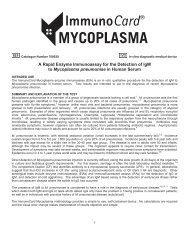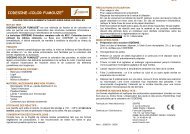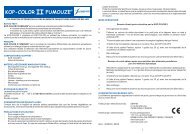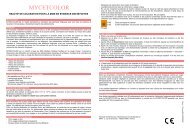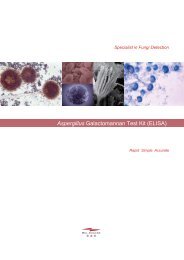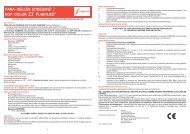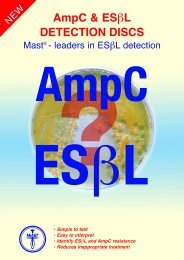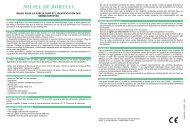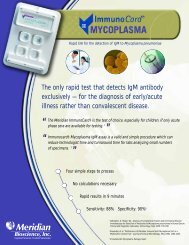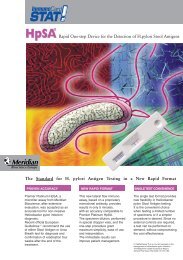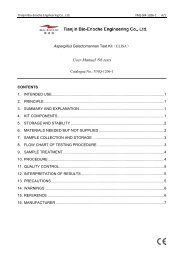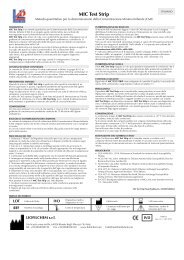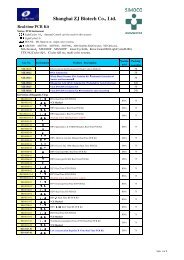MIC Test Strip
MIC Test Strip
MIC Test Strip
You also want an ePaper? Increase the reach of your titles
YUMPU automatically turns print PDFs into web optimized ePapers that Google loves.
<strong>MIC</strong> <strong>Test</strong> <strong>Strip</strong><br />
Quantitative technique for determining the Minimum Inhibitory Concentration (<strong>MIC</strong>)<br />
ENGLISH<br />
DESCRIPTION<br />
<strong>MIC</strong> <strong>Test</strong> <strong>Strip</strong> is a quantitative technique for determining the Minimum Inhibitory<br />
Concentration (<strong>MIC</strong>) of antimicrobial agents against microorganisms and for<br />
detecting the resistance mechanisms.<br />
<strong>MIC</strong> <strong>Test</strong> <strong>Strip</strong> are paper strips with special features that are impregnated<br />
with a predefined concentration gradient of antibiotic, across 15 two-fold dilutions<br />
of a conventional <strong>MIC</strong> method.<br />
On one side of the strip is indicated a <strong>MIC</strong> scale in "g/mL and a code that identify<br />
the antimicrobial agent.<br />
<strong>MIC</strong> <strong>Test</strong> <strong>Strip</strong> are available in a large variety of configurations.<br />
Each configuration is available in packages of 30 and 100 tests.<br />
CONTENTS OF THE PACKAGES<br />
The 30-test version contains 30 strips packaged in “blister”, in group of ten, with a<br />
dryer.<br />
The 100-test version contains 100 strips packaged in “blister”, in group of ten, with<br />
a dryer.<br />
Each package contains also a tube with a dryer and an instruction sheet.<br />
METHOD PRINCIPLE<br />
When the <strong>MIC</strong> <strong>Test</strong> <strong>Strip</strong> is applied onto an inoculated agar surface, the<br />
preformed exponential gradient of antimicrobial agent is immediately transferred to<br />
the agar matrix.<br />
After 18 hours incubation or longer, a symmetrical inhibition ellipse centered along<br />
the strip is formed. The <strong>MIC</strong> is read directly from the scale in terms of "g/mL at the<br />
point where the edge of the inhibition ellipse intersects the strip <strong>MIC</strong> <strong>Test</strong> <strong>Strip</strong>.<br />
COMPOSITION<br />
The strips are made of high-quality paper and each strip is impregnated with a<br />
predefined concentration gradient across 15 two-fold dilutions of antibiotic agent.<br />
GATHERING AND KEEPING SAMPLES<br />
The colonies that are to be subjected to the evaluation of Minimum Inhibition<br />
Concentration (<strong>MIC</strong>) are taken up by culture media that have been previously<br />
swabbed with the sample under examination. In the case of mixed colonies the<br />
bacterial strains must be purified before inoculation.<br />
TEST PROCEDURE<br />
1. Take the “blister” of cartridges from the refrigerator and leave it for about an hour<br />
at ambient temperature in order to prevent condensation forming on the strips<br />
when it is opened as such condensation could affect long-term stability.<br />
2. Swab 4 to 5 well isolated and morphologically similar colonies with a culture<br />
medium and suspend them in 5 mL of a suitable suspension medium. Fastidious<br />
microorganisms should be suspended in broth and used within 15 minutes.<br />
3. Compare the turbidity to the appropriate McFarland standard.<br />
4. Dip a sterile swab in the broth culture or in a diluted form thereof and squeeze it<br />
on the wall of the test tube to eliminate excess liquid.<br />
5. Drag it along the surface of the medium contained on the plate so as to produce<br />
even growth; allow excess moisture to be absorbed and ensure that the surface is<br />
completely dry before applying strips.<br />
6. Apply the strip to the agar surface with the <strong>MIC</strong> scale facing upwards and code<br />
of the strip to the outside of the plate, pressing it with a sterile forceps on the<br />
surface of the agar and ensure that whole length of the antibiotic gradient is in<br />
complete contact with the agar surface. Once applied, do not move the strip.<br />
7. Incubate plates in an inverted position under conditions appropriate for the<br />
microorganism.<br />
8. Put the not used strips onto the tube contained in the package.<br />
EVALUATING THE RESULTS<br />
At the end of incubation read the <strong>MIC</strong> value where the edge of the inhibition ellipse<br />
intersects the strip (intersection between two scale segments should be round up<br />
to the higher value).<br />
<strong>MIC</strong> break points for defining susceptibility categories as provided by the CLSI<br />
could be used for interpreting <strong>MIC</strong> values.<br />
Always round up <strong>MIC</strong> <strong>Test</strong> <strong>Strip</strong> half dilution values to the next upper two-fold<br />
value before categorisation. An overview of CLSI interpretative criteria is provided<br />
in Table no.1.<br />
CLINICAL INTERPRETATION<br />
The test <strong>MIC</strong> <strong>Test</strong> <strong>Strip</strong> carried out in vitro cannot exactly reproduce in vivo<br />
conditions. Nevertheless, it shows the effect of the concentration of the antibiotic,<br />
which varies in the culture medium in relation to the growth of the microbial<br />
population.<br />
The final choice of antibiotic to administer to the patient is the responsibility of the<br />
clinician who possesses all the information on the patient.<br />
QUALITY CONTROL<br />
Each batch of <strong>MIC</strong> <strong>Test</strong> <strong>Strip</strong> is subjected to precise and thorough checks in<br />
compliance with CLSI standards using the bacterial strains indicated in the table<br />
no. 1.<br />
PRECAUTIONS<br />
The <strong>MIC</strong> <strong>Test</strong> <strong>Strip</strong> cannot be classified as being hazardous according to current<br />
legislation but fall within the specific field of application where a safety datasheet<br />
must be supplied because they can cause phenomena of sensitisation in sensitive<br />
subjects if they come into contact with the skin.<br />
<strong>MIC</strong> <strong>Test</strong> <strong>Strip</strong> are disposable products. <strong>MIC</strong> <strong>Test</strong> <strong>Strip</strong> are only for diagnostic in<br />
vitro use and are intended for professional use. They must be used in the<br />
laboratory by properly trained operators using approved aseptic and safety<br />
methods for pathogenic agents.<br />
STORAGE<br />
The unopened package of <strong>MIC</strong> <strong>Test</strong> <strong>Strip</strong> should be stored at -20 - +8 °C until the<br />
given expiry date.<br />
Leftover <strong>MIC</strong> <strong>Test</strong> <strong>Strip</strong> from an opened package must be stored at 2-8 °C in the<br />
airtight tube, containing desiccant, provided in the pack until the expiry date.<br />
Do not store them near sources of heat and do not expose them to excessive<br />
temperature variations.<br />
Do not use after this date.<br />
Dispose of if they show signs of deterioration.<br />
ELIMINATING USED MATERIAL<br />
After use, <strong>MIC</strong> <strong>Test</strong> <strong>Strip</strong> and the material that comes into contact with the sample<br />
must be decontaminated and disposed of in accordance with current laboratory<br />
techniques for the decontamination and disposal of potentially infected material.<br />
BIBLIOGRAPHY<br />
• Performance Standards for Antimicrobial Susceptibility <strong>Test</strong>ing.<br />
NCCLS M100-S Series , latest annual edition.<br />
• Methods for Dilution Antimicrobial Susceptibility <strong>Test</strong>s for Bacteria that Grow<br />
Aerobically. NCCLS M7-A6, 2003.<br />
• Methods for Dilution Antimicrobial Susceptibility <strong>Test</strong>ing of Anaerobic Bacteria.<br />
NCCLS M11-A6, 2004.<br />
TABLE OF SYMBOLS<br />
LOT Batch code IVD<br />
In Vitro Diagnostic<br />
Medical Device<br />
Manufacturer<br />
REF Catalogue number Temperature limitation Contains sufficient for <br />
tests<br />
Use by<br />
Caution,consult<br />
accompanying documents<br />
LIOFILCHEM s.r.l.<br />
Via Scozia zona ind.le, 64026 Roseto degli Abruzzi (Te) Italy<br />
Tel. +39 0858930745 Fax +39 0858930330 www.liofilchem.net liofilchem@liofilchem.net<br />
IVD<br />
F00023<br />
Rev.4 / 31.03.2009<br />
2



